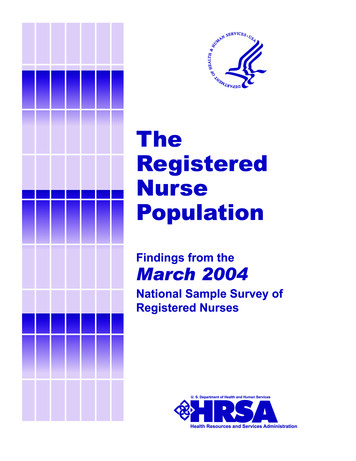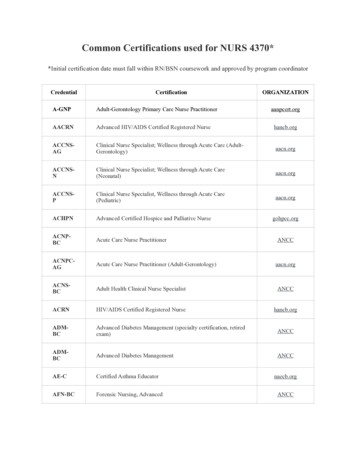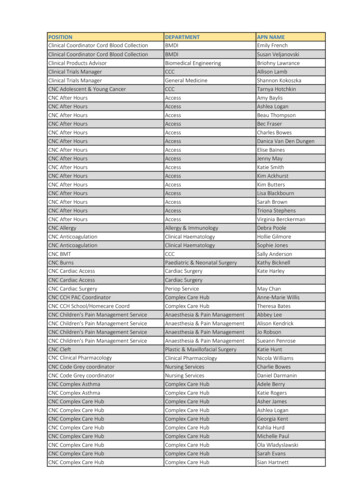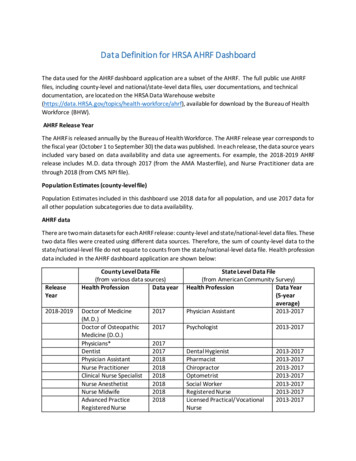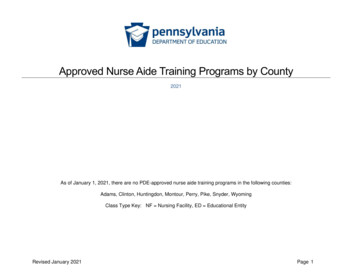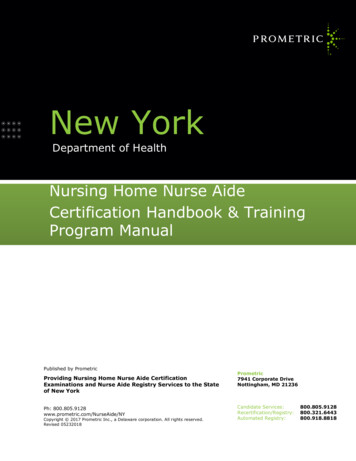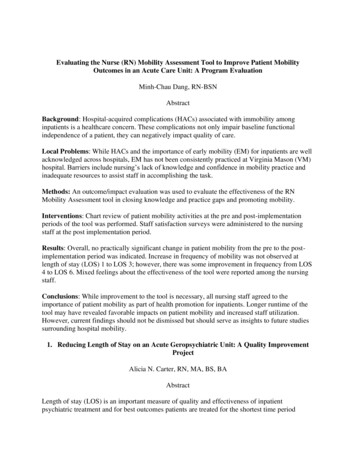
Transcription
Evaluating the Nurse (RN) Mobility Assessment Tool to Improve Patient MobilityOutcomes in an Acute Care Unit: A Program EvaluationMinh-Chau Dang, RN-BSNAbstractBackground: Hospital-acquired complications (HACs) associated with immobility amonginpatients is a healthcare concern. These complications not only impair baseline functionalindependence of a patient, they can negatively impact quality of care.Local Problems: While HACs and the importance of early mobility (EM) for inpatients are wellacknowledged across hospitals, EM has not been consistently practiced at Virginia Mason (VM)hospital. Barriers include nursing’s lack of knowledge and confidence in mobility practice andinadequate resources to assist staff in accomplishing the task.Methods: An outcome/impact evaluation was used to evaluate the effectiveness of the RNMobility Assessment tool in closing knowledge and practice gaps and promoting mobility.Interventions: Chart review of patient mobility activities at the pre and post-implementationperiods of the tool was performed. Staff satisfaction surveys were administered to the nursingstaff at the post implementation period.Results: Overall, no practically significant change in patient mobility from the pre to the postimplementation period was indicated. Increase in frequency of mobility was not observed atlength of stay (LOS) 1 to LOS 3; however, there was some improvement in frequency from LOS4 to LOS 6. Mixed feelings about the effectiveness of the tool were reported among the nursingstaff.Conclusions: While improvement to the tool is necessary, all nursing staff agreed to theimportance of patient mobility as part of health promotion for inpatients. Longer runtime of thetool may have revealed favorable impacts on patient mobility and increased staff utilization.However, current findings should not be dismissed but should serve as insights to future studiessurrounding hospital mobility.1. Reducing Length of Stay on an Acute Geropsychiatric Unit: A Quality ImprovementProjectAlicia N. Carter, RN, MA, BS, BAAbstractLength of stay (LOS) is an important measure of quality and effectiveness of inpatientpsychiatric treatment and for best outcomes patients are treated for the shortest time period
necessary to stabilize their acute illness. However, Providence Milwaukie Hospital’s SeniorPsychiatric Unit’s (SPU) ALOS in 2019 was 24 days, significantly longer than the goal of 10 to12 days. Increased LOS is associated with unnecessary financial costs, delay in care for patientswaiting to be admitted, and increased risk for adverse outcomes. This quality improvementproject involved the development and implementation of an interdisciplinary care pathway (ICP)for geropsychiatric patients with a dementia diagnosis and at risk for prolonged LOS. The projectresulted in a decrease of 10 days in the ALOS, which is a cost savings of approximately 16,000per case. While the outcomes did not reach statistical significance, the findings are promisingand suggest the implementation of an ICP can be effective in reducing ALOS.2. Implementing an Intraosseous Vascular Access Program for Emergency DepartmentRegistered Nurses: A Quality Improvement ProjectJacqueline Flowers, BSN, RN, CENAbstractBackground: Patients with difficult venous access presenting to the emergency department areat risk for experiencing multiple failed peripheral intravenous attempts and subsequent treatmentdelays. To facilitate the timely treatment of critical patients, intraosseous vascular access is thefirst-line alternative to peripheral intravenous cannulation.Gap in Practice: Intraosseous vascular access is the nursing standard of practice supported bymany professional organizations and nurse-targeted intraosseous programs have demonstratedsuccess in the literature. However, this valuable skill was excluded from the emergencydepartment registered nurse scope of practice at MultiCare Tacoma General Hospital.Aims. The overreaching goal of the project was the successful implementation of intraosseousvascular access program for emergency department registered nurses.Interventions: The nursing scope of practice was expanded to include intraosseous vascularaccess. An intraosseous vascular access training program was then implemented utilizing acombination of didactic and hands-on learning.Findings. The intraosseous vascular access training program was highly rated and provided thetraining necessary to perform the skill in clinical practice, including a 100% first-pass successrate and zero resulting adverse patient events. One hundred percent of emergency departmentnurses surveyed also reported the project had a positive impact on their clinical practice.Implications to practice. The program outline may be utilized as a blueprint for otherorganizations wishing to implement a similar nurse-targeted intraosseous vascular access trainingprogram. Although the perceived impact of the project on clinical practice was favorable, furtherevaluation is needed to determine its effect on vascular access delays and patient outcomes.
3. Improving ED RNs’ Safety During AMA Discharge: A Quality Improvement ProjectKelly L. WitbeckABSTRACTEmergency Department nurses at Legacy Salmon Creek Hospital were experiencing violentpatient encounters during AMA discharges. Further investigation revealed no policy norprocedure to assist nurses during this potentially volatile process. Type II violence, or workplaceviolence, like AMA discharge is also a phenomenon that is prevalent in the ED setting. Twophenomena present in one high risk setting where nurses are not equipped with proper practiceguidance increases the nurses’ risk for Type II violence encounters. When nurses are notprovided the appropriate education and training that provides them with the knowledge of theirroles and responsibilities their safety is put at risk. Project objectives were to improve safety ofED RNs during AMA discharge with an overall goal to decrease rates of Type II violence duringAMA discharge. Following the IHI Framework for Improving Joy in Work, continuous PSDAcycles were used to develop and partially implement an AMA discharge practice guideline,AMA discharge algorithm, risk factor assessment and education intervention to decrease Type IIviolence during AMA discharge. A mixed methods approach was planned, although no outcomedata was collected due to several delays effecting the project timeline, and the onset of the globalCOVID-19 pandemic. However, the QI project provided essential progress towards improvementof safety during AMA discharge. Stakeholder management and commitment to physical andpsychological safety is required of all institutions and health systems. Future implications forresults showed a need for additional continuous intervention implementation and highlighted theimportance in selecting key stakeholders in order to successfully implement projectinterventions.4. A Program Evaluation of a Southwest Washington National Alliance on Mental Illness:STRivE ProgramGareth J. Penta, BSN, RNAbstractBackground: An increasing body of evidence provides data showing that interventions directedat strengthening interpersonal skills yield decreased homelessness, increased utilization ofmedical and mental health care, decreased social isolation, and increased rate of recovery. Thepurpose of this program evaluation is to assess if the National Alliance on Mental Illness(NAMI) Southwest Washington STRivE Program is effective in achieving these goals.Local Problem: Care and resources for those with MI and SUD in Clark County, WA areinsufficient. This at-risk population has a heightened propensity for homelessness, socialisolation, and low rates of treatment for medical and mental health comorbidities.Methods: A program evaluation using quantitative and qualitative methods was conducted toassess if the SW WA NAMI STRivE program is meeting its goals.
Intervention(s): The Center for Disease Control (CDC) model for program evaluation was usedto identify variables of the STRivE program that improve outcomes for individuals with mentalillness and or substance use disorder through education to enhance interpersonal skills. At theconclusion of the evaluation, findings were disseminated to SW WA NAMI leadership.Measures: Quantitative measures assessed changes in employment, housing, and substance usestatus, and on the utilization of STRivE courses. Qualitative measures identified recurringthemes, which were helpful in assessing for changes in participants’ behavior, perceptions, skills,and attitude.Analysis: Quantitative and qualitative data were collated and analyzed at the end of the 10-weekSTRivE course cycle to identify if the program was meeting its goals.5. An Evaluation of a Transition of a Care Intervention at a Federally Qualified HealthCenter: A Program EvaluationFidel Hernandez Jr BSN, RNAbstractBackground: A Federally Qualified Health Center (FQHC) in Washington State hasimplemented a Transitions of Care (TOC) program to improve patient outcomes, reduce hospitalreadmissions, and diversify revenue streams.Local Problem: The FQHC identified in 2017 that only 25% of its patient population wasscheduled for primary care provider appointment within seven days of discharge and was failingto meet CMS criteria for transition of care. The organization implemented a Transition of Care(TOC) program in June of 2018 to improve this number and meet CMS criteria. Theeffectiveness of the TOC program has not been evaluated.Methods: This DNP project used quantitative and qualitative methods to assess the performanceof the TOC program.Intervention(s): A program evaluation using the Lean Six Sigma framework was used toidentify the factors contributing to not meeting TOC program goals. Upon conclusion of theevaluation, evidence-based recommendations were made to leadership about options toimplement to improve outcomes.Measures: Quantitative measures tracked the frequency goals are met. Qualitative measuresidentified the processes that hinder the completion of goals within the specified timeframe. CMScriteria for an effective and reimbursable TOC service are the focus of all measures.
Analysis: Quantitative data was aggregated and analyzed monthly to provide baseline data.Qualitative data was reviewed at the end to identify wasteful processes.Results: Quantitative data indicates that outcomes necessary for reimbursement are not beingmet. Each county evaluated would be reimbursed for less than 25% of the patients it attempted toengage for TOC services. Qualitative data indicates that the barriers to meeting outcomes arecommunication, provider availability, and lack of patient participation.Recommendations: It is recommended that further analysis of qualitative data is necessary toextrapolate what is working and eliminate what is not. Program evaluations focused on eachspecific county individually will provide improvement on data collection and qualitative dataanalysis.6. Interprofessional Dedicated Education Unit as a Strategy to Reduce CommunicationRelated Errors: A Program EvaluationAngie Bailey, MN, BSN, RNAbstractAt least thirty percent of medical errors can be correlated with communication breakdownsamong healthcare providers and the increasingly complex care of patients is dependent uponcritical communication and multiple handoffs between members of the healthcare team. Theclinical agency has begun expanding the interprofessional dedicated education unit (IPDEU)model to include additional disciplines with the intent of improving patient outcomes. Noevaluation has been completed on the initial pilot implementation.The RE-AIM model was used to conduct a comprehensive evaluation, gauge readiness forexpansion of the model, and provide evidence-based recommendations. Patient and staffoutcomes were examined and compared between a baseline period and the pilot timeframe.There was no statistically significant variation in average length of stay, readmission rates orpatient harm events between the baseline and pilot timeframes. Press Ganey HCAHPS surveyresults show a statistically significant decrease in discharge information scores, however, thechange can be attributed to a system wide policy change. Staff engagement scores remained veryhigh throughout the pilot timeframe. Surveys show staff value working with interprofessionalstudents and support are ready to embrace development opportunities to support their work in theIPDEU model. There is a need for ongoing program evaluation and quality improvement effortsto assess and optimize the IPDEU model. The exploration of IPDEU projects is useful as it couldlead to improved patient and staff outcomes. Further study of similar models is warranted as isthe development of IPDEU opportunities in the ambulatory setting.
7. Tobacco Use Screening in Outpatient Wound Care: A Quality Improvement ProjectJessica Shuell BSN, RNAbstractThe PeaceHealth Southwest Wound Healing and Hyperbaric Oxygen Center has a substantialnumber of patients documented to be users of tobacco products. Tobacco use significantly delayswound healing and reduces the therapeutic effects of hyperbaric oxygen treatments. Suboptimalcaregiver screening rates of tobacco use and readiness to quit is a known problem at the woundclinic. Gaps in knowledge pertaining to workflow use and cessation counseling contribute todecreased caregiver adherence. The risk of not improving screening rates includes potential lossof federal grant funding and adverse patient outcomes. Evidence supports the value of nursesoffering motivational support to improve sustained tobacco cessation. The 5 A’s mnemonic is anevidence-based brief intervention that is nationally endorsed to improve tobacco cessation.Utilizing the Knowledge to Action framework and Kotter’s 8-Steps of Change supported thedevelopment and implementation of an education-driven quality improvement project. Thisquality improvement project aligns with the Institute of Medicine’s domains of health carequality by providing patient-centered, timely, efficient, and equitable tobacco screening andintervention, which optimizes wound healing and health outcomes. A task force was assembledto develop an educational intervention that was evidence-based and mitigated barriers. Deliveryof the educational content during a nurse staff meeting demonstrated a 32% increase in learningpre/post testing. Eight weeks of manual chart reviews were collected pre and post the date of theeducational intervention. There was an increase in screening and counseling of new patients of11% and 8% respectively during the post-intervention phase. The impact of the educationalintervention on the observed increase in screening and counseling cannot be inferred. Semistructured interview theme codes helped inform the quantitative results. Strengths of this qualityimprovement project included improved caregiver communication, increased use of patienteducational instructions, and visual aid utilization. The quality improvement model falls outsideof the realms of formal research limiting the generalizability of these findings.Recommendations to institutional stakeholders are to enlist the provider group to develop aworkflow in the electronic health record that contains the components known evidence-basedpractice. Future research is needed to inform meaningful practice changes in tobacco usescreening in the setting of outpatient wound care.8. Anti-Inflammatory Diet: A Quality Improvement Practice Change for aNutritionalIntervention for Chronic Pain PatientsElizabeth Spokoiny MN, RN-BCAbstractBackground: Chronic non cancer pain remains a leading cause of disability in the United Stateswith associated costs of 560 billion annually. The National Pain Strategy calls for multimodaltreatment paradigms for chronic pain. Diet and nutrition are part of a complex relationship with
the experience of chronic pain. Low-grade chronic inflammation is now known to be a driver ofmost chronic degenerative diseases.Problem: The University of Washington Center for Pain Relief (UWCPR), a tertiary pain clinic,serves chronic pain patients in the Northwest. Treatment paradigms do not routinely emphasizenutrition despite compelling evidence that nutritional strategies are efficacious, safe, and costeffective for non-cancer pain.Aims. The overreaching goal of the project was to implement an anti-inflammatory (AI)nutritional treatment modality for chronic pain patients that would become routine practice forclinic physicians.Interventions: All clinic physicians were educated on AI and trained to use motivationalinterviewing techniques to introduce AI to patients. The targeted physician education increasedphysician knowledge and confidence on AI principles. Physician practices were expanded by thenow routine prescribing of AI as an adjunct non-drug treatment. Physicians were provided withevidenced based resources for patients.Findings. Eighty-eight percent of clinic physicians increased their knowledge of AI for chronicpain and are 50% more likely or extremely likely to use evidenced based resources with patients.Implications to practice. The program may serve to facilitate more integrative focused clinicprogramming emphasizing non-drug options amidst the opioid crisis aligning with the NationalPain Strategy. Pain patients may have improved symptom control with the tenets of AI9. A Program Evaluation of Skin Assessment in a Progressive Care UnitKim-Tien Pham, BSN, RNAbstractHospital-acquired pressure ulcers (HAPUs) have been a major problem in hospitals for manydecades. The negative emotional, financial, physical, and spiritual impacts of a pressure ulcer(PU), as well as associated treatment costs ranging from 10,000 to 86,000 per PU,demonstrates the importance of preventing HAPUs. Although prevention of HAPUs through skinrisk assessments and preventive strategies have been a top priority, HAPU eradication stillremains challenging. The problem is that a recent skin audit in the Progressive Care Unit (PCU)revealed troubling results. A program evaluation (PE) utilizing the Centers for Disease Controland Prevention (CDC) PE model was implemented to assess the knowledge and satisfaction ofthe staff and to evaluate the effectiveness of the current skin assessment program (SAP) in thePCU. Program outcome results demonstrated that the percentage of accurate, completed PCUskin assessments at admission or transfer decreased during the evaluation period. Levels of staffknowledge and satisfaction with the skin assessment program were found to be sufficient to carryout the assessments. These program evaluation results indicate that further action is needed toestablish an effective skin assessment program in the PCU.
10. Reducing 30-Day All-Cause Readmission of Heart Failure: A Quality ImprovementProjectKaelin Vince-Cruz BSN, RN DNP StudentAbstractBackground: In 2012, President Obama implemented a financial reimbursement program forhospitals to reduce 30-day all-cause readmissions for diagnoses such as heart failure (HF).However, about 27% of hospitalizations for HF are still readmitted within 30 days of a hospitaldischarge.Local Problem: St. Francis Hospital in Federal Way, WA struggled to consistently maintaintheir monthly goal for 30-day all-cause readmission of HF (RHF) at no more than 15.4%.Method: Two cycles of the Plan-Do-Study-Act (PDSA) method occurred and focused on adischarge checklist (DC) for HF and staff satisfaction on the nursing process change.Intervention: The project started with educating staff on a DC to reduce 30-day all-causereadmission of heart failure (RHF). A voluntary survey occurred at 45 and 90 days postintervention to measure staff satisfaction on the nursing process change. The interventionoccurred from August 28th, 2019 through November 30th, 2019.Results: Initially, 16 DC were collected, however only 12 were fully completed and underwentdata analysis. There were 4/12 (31%) 30-day all cause RHF, leaving 8/12 (62%) of patients withnon-30-day all-cause RHF. There were two non-30-day all-cause RHF who passed away.Overall, staff agreed that the DC had potential to reduce 30-day all-cause RHF and was easy toimplement into their nursing practice.Conclusion: The use of a DC for patients with HF on the third medical unit was successful on30-day al-cause RHF. Additionally, staff embraced the nursing process change. Furtherinformation is needed to support the findings of this QI project.11. Implementing and Evaluating a Quality Improvement Project to Reduce UnnecessaryDiagnostic Imaging in Urgent CareJill Lawton MSN, BSN, ARNP, RNAbstractAcute knee injury in young adults and children is one of the most common injuries seen inemergency departments (ED). Despite low fracture rates, usually associated with only blunt forcetrauma, plain knee radiographs are one of the most common tests ordered for any type of kneeinjury (Elshaug et al., 2017). Currently, there are clinical decision rules (CDR) in place to guidethe ordering of knee films for complaints of acute knee pain. However, results of a needsassessment indicated the nursing staff at Kaiser Longview Urgent Care (UC), the primary site for
the current project, are unaware of the CDR and protocol. Interviews with the clinic providersrevealed that while the providers were aware of the CDR, they were unaware that it was Kaiserpolicy and were not using them. The purpose of the current project was to address this practice toknowledge gap and implement evidence-based guidelines, the Ottawa Knee Rules (OKR), intriage at the Kaiser Longview Urgent Care. The change in practice was instituted over a fourmonth period, and data were collected pre- and post-intervention. The intervention showed adecrease in the number of knee films ordered in the UC over the project period.12. Reducing High Healthcare Utilization Among Individuals Affected by Negative SocialDeterminants of Health: A Program Evaluation.Samwel Mbua BSN, RN, CCRN, DNP-FNP candidate,AbstractHigh healthcare utilization (HHU) is a problem that substantially contributes to increasedhealthcare expenditures. HHU results when individuals faced with negative social determinantsof health (SDoH) such as homelessness, mental illness, and disease comorbidity overuseemergency room and hospital services for avoidable reasons. HHU is a major healthcare problemin Highline Medical Center (HMC). In 2017 at HMC, 55 individuals faced by homelessness anddisease comorbidity accounted for 511 ER visits in a period of six months, resulting in 856,833of uncompensated care. In 2014, Health Connections was established at HMC to reduce HHU.Until 2018, Health Connections utilized a metric scoring based on length of hospital stay, acuity,comorbidity, and ER visit also known as (LACE) to enroll patients who have a score of ten orgreater. In 2018, Health Connections expanded services and integrated additional screening toolknown as Predictive Risk Intelligence System (PRISM). This program evaluation assessed theeffectiveness of the expanded Health Connections services.13. Robotic Companion Animal Therapy: A Quality Improvement Project in a VeteransAffairs Hospice UnitDiep Nguyen RN, FNP- DNP StudentAbstractThe increased utilization of hospice care for veterans in recent years has motivated the VeteranHealth Administration (VHA) to focus on the expansion of its hospice services to includeimproving end-of-life care. Nationally, the IOM reported the widespread dissatisfaction in endof life care (IOM, 1997 and 2014). The Puget Sound VHA, the Community Living Center (CLC)has a lower family perception of quality of end-of-life care when compared to the in-patienthospice and palliative care units (Ersek et al., 2015). This project aims were to address theconcerns of the VA Puget Sound leadership by improving the physical and psychosocialsymptoms and the well-being of the hospice patient. Guided by the Health-Related Quality ofLife (HRQoL) and using the Robotic Companion Animal Therapy (RCAT) intervention, thisintervention was implemented for veterans on the hospice service at the CLC of the VA PugetSound hospital and will be evaluated using quantitative and qualitative methodologies.
14. Improving Diabetes Self-Management in Older Russian/Slavic Immigrants: A QualityImprovement ProjectOlga P. Tsytsyna, FNP-DNP Student, BSN, RN-BCAbstractDiabetes mellitus type II is a worldwide pandemic that affects about 382 million people due tohigh-calorie, low-nutrient diet and sedentary lifestyles. Immigrant populations are at increasedrisk for developing diabetes and its related comorbidities given the acculturation to Americannutrition selections and physical inactivity (Parr & Elmendorf, 2015), social and religious values,language barriers, and low health literacy (Razum & Steinberg, 2016; Smith-Miller, Berry,Dewalt, & Miller, 2016).The purpose for the DNP project was to develop and implement a culturally appropriate diabetesself-management program for elder Russian population at Sunrise Family Medical Clinic, HappyValley, OR. Using Orem’s Self Care model, the goal of the program was to develop individuallyfocused self-management skills with emphasis on diet modification, medication adherence,physical activity, and glycemic control. The expected outcomes: decreased HgA1C by 10-12%and increased patients’ performance within a 3-month time frame.15. Enhancing the depression screening in cancer patients: A Quality Improvement ProjectGrace Mwangi, DNP-FNP student, RN-BSNAbstractDepression affects more than 300 million people worldwide. In patients with cancer, the reportedprevalence is approximately 25% of cancer patients. Inadequate screening and treatment ofdepression can lead to delayed or no treatment, causing reduced quality of life and survival.Despite the high prevalence and considerable impact of depression in the oncology outpatientcare setting, identification had been suboptimal. At Seattle Integrative Cancer Center (SICC),there were no set guidelines for depression screening and management, this quality improvementproject aims to implement the current standard guidelines by the American Society of ClinicalOncology (ASCO) screening and management of depression in adults with cancer. The goal wasto increase the efficacy of screening, interventions, referral, follow-up and treatment fordepression, to 80% screening percentage. The second objective was to increase the cancer patientretention rate to remain in cancer treatment by at least 5% within 60 days. The use of a newdepression protocol for cancer patients with depression at SICC was successful. Additionally,staff embraced the nursing process change. Further information is needed to support the findingsof this QI project.16. Implementing Code Sepsis in Acute Care at Northwest Hospital: A QualityImprovement ProjectTera Giles:Abstract
Sepsis is considered a medical emergency requiring immediate medical treatment. Sepsis has ahigh mortality rate, with a third of all in-hospital deaths being a result of sepsis (CDC, 2016).Patients that become septic while in the hospital have a mortality rate of 25.5% (Rhee et al.,2017). Recently published international sepsis guidelines call upon hospitals to be activelyscreening for sepsis on all acutely ill patients (Rhodes et al., 2017). Northwest Hospital (NWH)in Seattle, Washington has an active Sepsis Quality Improvement committee. The existing codesepsis program is utilized in the emergency department (ED) where high levels of Centers forMedicare and Medicaid Services (CMS) compliance are met. Acute care units at NWH performbelow the national average for CMS sepsis compliance. This quality improvement projectevaluated the implementation of an inpatient code sepsis program at NWH. The interventionyielded mixed results. Self-assessed nursing knowledge about sepsis identification andintervention improved after educational session, staff nurses responded favorably to satisfactionquestions about the intervention, but nursing usage of the code sepsis intervention wasinconsistent. In spite of mixed results, the intervention was useful in moving the hospitaltowards international best practice guidelines.19. Initiating A Falls Prevention Screening Program: A Quality ImprovementProjectJessica Small:AbstractBackground: Falls in the elderly are devastating. The aftermath of a fall impacts the healthcareindustry as a whole, the family, the community, and the elder who experienced the fall. Falls canbe prevented in elder homes and around the community. Facilities that provide primary care toelderly should have a process in place to identify those at greater risk of falling and follow stepsto help prevent falls.Local Problem: The Chehalis Tribal Wellness Center is a rural family clinic. It did not have aprocess in place to screen elders, age 60 and older, for risk of fall. There was also no area in thecurrent electronic health record to quickly find this assessment or risk status.Methods: A literature review was conducted in CINHAL, Cochrane, and Medline. The searchterms used were “falls prevention screening” and “falls prevention”. The search was limited tofull text and peer reviewed articles. Articles were included if they had included participants age60 years or older and had a fall prior to the study. Articles excluded if the fall was in a hospital orlong-term care facility, and not community prevention based.Intervention(s): The interventions were specific to the goal of increasing screening in the elderpopulation. The interventions were evidence based and followed the Center for Disease Controland Prevention’s Stop Elderly Accidents, Deaths, and Injuries program. The interventions werefocused on medication reviews, physical exams, education, and referrals to the Chehalis TribalWellness Centers’ falls prevention team. The interventions included medical staff education onfalls prevention, how to complete a screening, and how to place a referral to the stay active andind
hospital. Barriers include nursing's lack of knowledge and confidence in mobility practice and inadequate resources to assist staff in accomplishing the task. Methods: An outcome/impact evaluation was used to evaluate the effectiveness of the RN Mobility Assessment tool in closing knowledge and practice gaps and promoting mobility.




